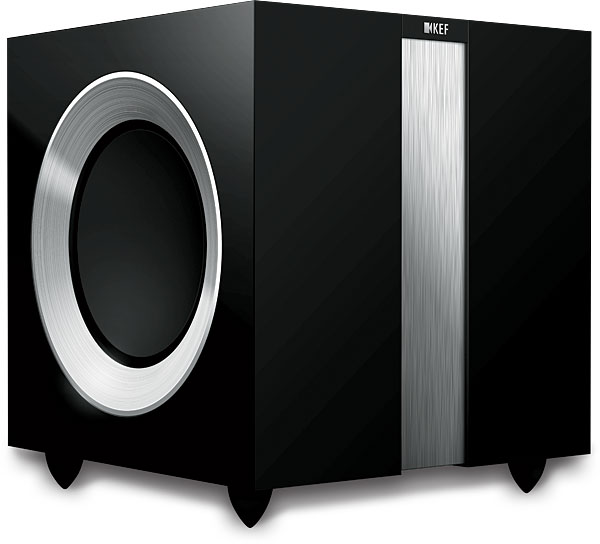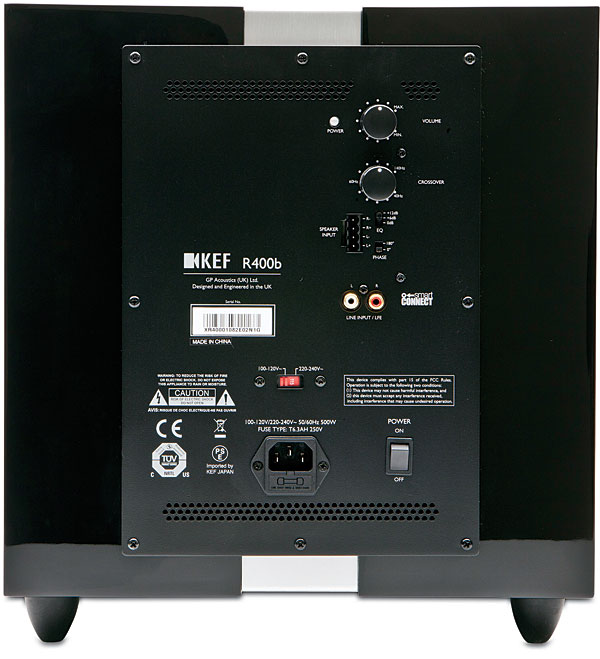KEF R300 Speaker System Page 2
R400b Subwoofer
The R400b subwoofer, with its dramatic metal stripe running across the top and down the front, has two 9-inch drivers on either side of the enclosure—a design feature borrowed directly from the Blade tower. The opposing drivers both move outward or inward together, so that their vibrations cancel and don’t transfer to the cabinet. KEF uses an acoustic suspension enclosure—in other words, a sealed box—eliminating the port and any concomitant turbulence. While it’s possible to design a great-sounding woofer that gets some of its output from a port, the sealed-box approach provides a more disciplined feel that, in my opinion, serves music better and makes the low-frequency effects of action movies a little less aggressive and vulgar. Each aluminum driver is propelled by a 250-watt, Class D amplifier, for a total output-power rating of 500 watts. KEF provides stereo RCA line-level inputs and plug-in speaker-level inputs. In addition to the usual volume knob, crossover knob, and phase switch, there’s a three-setting bass boost (0, +6, +12 decibels) centered on 40 Hz. I was never less than satisfied with the zero setting.

KEF’s distinctive approach to everything includes the troubleshooting section of its manual, or in KEF-speak, the Fault Finding section. It takes the form of three columns labeled Problem, Action, and Cause. The columns contain graphics representing speakers, amplifiers, and cables—which are further decorated with icons that signify working, not working, switch cables, treble, midrange, bass, intermittent sound, and distorted sound. The master list of icons is captioned in 15 languages, but apart from that, the approach is primarily pictorial, and it saves many pages of multilingual duplication.
For this review, associated equipment included a Pioneer Elite VSX-53 A/V receiver, a Panasonic DMP-BD87 Blu-ray player, a Micro Seiki BL-51 turntable (a mint-condition vintage model making its Home Theater debut), an Onix OA 21s integrated amp operating as a phono preamp, and a Shure M97xE moving-magnet cartridge. All movie demos were Blu-ray Discs with DTS-HD Master Audio soundtracks. Music demos were primarily analog, with just enough digital to plant a foot in the present tense.
Actorly Enunciation
I interrogated these speakers at unusual length, looking for positive and negative traits that I might translate into words. The list of positives was long and the list of negatives almost blank. My only reservation was the diffuseness of surround effects, but that was more an inherent characteristic of dipole surrounds than a performance flaw. My preference for surround monopoles (that is, conventional speakers) is becoming more pronounced with the passage of time. Aside from that, these speakers delivered everything I hope for when I sit down to listen to music or movies.
One of those things was a tonal balance I found free from gross flaws and subjectively pleasing. Whether it’s objectively truthful, I’ll leave that to the measurements. There were individual pleasures to be had in every band of the frequency spectrum, from palpably physical midbass to top-end air. And the R400b sub delivered the lower bass in just the kind of subtle, sealed-box fashion I prefer.
But the part that was most refreshing—like a pint of good bitter made with aromatic Kentish hops—was the clean and beau- tifully proportioned midrange, which made voices in particular communicate at a Shakespearean level of achievement. Both the actor (to continue the metaphor) and the soundstage on which he played were focused to a fare- thee-well, a strength of the coaxial midrange-tweeter array. Objects were physically solid and had discernible—but not cartoonishly overdrawn—boundaries within a well-depicted space. This was as true in 2.0 and 2.1 channels as in 5.1, although the point-ones were of course better filled out at the bottom end. My comfort level was high, and my emotional pleasure receptors were comprehensively stimulated.
One thing that distinguishes a great speaker is that it changes the way you listen—for the better. When I hit the play button on Dream House, a haunted-homeowner tale starring Daniel Craig, avoiding discomfort never became a preoccupation. Instead, I concentrated on finding the right balance of dialogue, effects, music, and surround envelopment. Rather than start high and push the volume down, I started low, because the coaxial array made enunciation so unambiguous that I had no trouble catching dialogue at levels probably lower than the mixer intended. When it became apparent that left/right and front/back effects were elusive, and the soundfield was too front loaded, I pushed up the master volume to achieve more palpable dynamics, more detail, and more sense of space; basically, I wanted more of everything. Music was so vivid that I was tempted to pause the movie and enjoy a symphony or six (and when I eventually did, the system did not disappoint).

I continued to ride the Daniel Craig train with the American remake of The Girl With the Dragon Tattoo. The cover version of Led Zeppelin’s “Immigrant Song” grabbed me by the throat. I continued dialing in surround effects until howling winds really howled in all five channels. Now I could hear a pin drop—or could have, if someone had dropped one. What I did hear was heightened detail in indoor scenes (the gentle creak and rustle of clothing) and heightened ambience in outdoor ones (nonviolent in-car hum and the gentle movement of air) as the R300, R600c, and R800ds combined to produce an involving soundfield. When the drama hit its peaks, I was on the edge of my seat and in a different world—ears comfortable but emotions tense. If this movie had lasted another 10 minutes, tattoos and piercings might have spontaneously broken out on my body.
Recoil—with former wrestler Steve Austin as a vigilante ex-cop who takes on a gang of equally bulky leather-jacketed thugs—is the kind of high-energy action movie that flattens inner-ear hairs at a dozen paces. In other circumstances, I might have used a low-volume mode to take the edge off. (Indeed, the Pioneer’s THX Loudness Plus mode did just that for a few minutes.) But because the speakers rendered dialogue so intelligibly, I could cruise at a low volume and catch everything. The sub’s carefully measured bass made low-frequency effects not only bearable, but pleasurable. Again, I eagerly anticipated moving on to music.
Dancing Diamond
I listened to a lot of analog and two-channel material while the
R Series was in town—fittingly, because KEF’s history starts in the vinyl era, and the company began its upward trajectory when the average listener plowed black grooves with a dancing diamond.
The Nick Drake compilation Time of No Reply includes a combination of studio tracks and home demos. Concentrating on the former (impeccably engineered by John Wood), I mar- veled at how the R300 defined the dark-toned, mellifluous voice as a distinct object in discernible space. Drake’s voice had a depth that was well served but not exaggerated by the woofers and sub drivers. The sub’s contribution was so subtle that I had to feel the drivers with my fingers to make sure they were operating. The voice was also rich in overtones and breath, none of which was missed by the scrupulous midrange/tweeter array. The rhythm of Drake’s acoustic guitar was snappy, as the woofers did an excellent job of delivering Drake’s finger-picking pulse. The guitar’s harmonic signature rang true.
I played through all six Vaughan Williams symphonies as conducted by Sir Adrian Boult with the London Philharmonic and the New Philharmonia on a series of Angel LPs. By the end of the cycle, I had no doubt that the speaker could produce a convincing string sound in a half-dozen distinctive ways. You may be able to spot the woofer-mid and mid-tweeter crossovers in laboratory measurements, but I couldn’t spot them in the orchestra.
The defining demo was the set of Piano Etudes by Bartók, Busoni, Messiaen, [and] Stravinsky that Paul Jacobs recorded for Nonesuch. As reproduced by the R Series, the LP was timbrally, harmonically, and rhythmically ideal: as close to having a Baldwin grand in my listening room as I’ve ever heard. The sub and speakers dovetailed beautifully at the crossover, allowing slick transitions between the pianist’s left and right hands as he roved up and down the keyboard. I’m not kidding when I say this is something I’ll remember all my life.
This seemed to be the right time to play 50 Years of Innovations in Sound, the CD compilation KEF produced for its 50th anniversary last year. It’s a refreshingly non-audiophile selection of songs—but even the most finicky listener would love Astrud Gilberto’s honeyed vocal on the famous version of “The Girl from Ipanema” recorded with João Gilberto and Stan Getz. Secret Garden’s contemporary gospel classic “You Raise Me Up” was remarkable for both the warmth of its solo violin and the holographic vividness of the choral vocals—further triumphs for the midrange/tweeter array. The speakers were capable of making astonishingly tiny distinctions: Tackling the piano part on Nina Simone’s “Love Me or Leave Me,” they depicted each hammered note as a group of steel strings. I noted the distinction between these discrete microtimbres and the more unified sound of the piano in the Paul Jacobs selection.
Conclusion
It’s not always safe to assume
that a company with a grand reputation will deliver on it with each and every product. At the same time, it’ll probably surprise no one that the R Series is worthy of its audiophile lineage. The series is beyond excellent, moving aggressively into I-could-live-this territory. I’m struck by how much this system excelled in the human dimension—that is, the reproduction of speaking and singing voices, although it also handled pretty much all instruments and effects with aplomb. And unlike a lot of audiophile speakers, these are no challenge for a decent-quality AVR to run at a variety of levels, from coherent whisper to rambunctiously rockin’. These are simply extraordinary loudspeakers.
(One final word: If you can’t find KEF products, or a particular one, for sale close to home, you can order them directly from kefdirect.com.)





























































